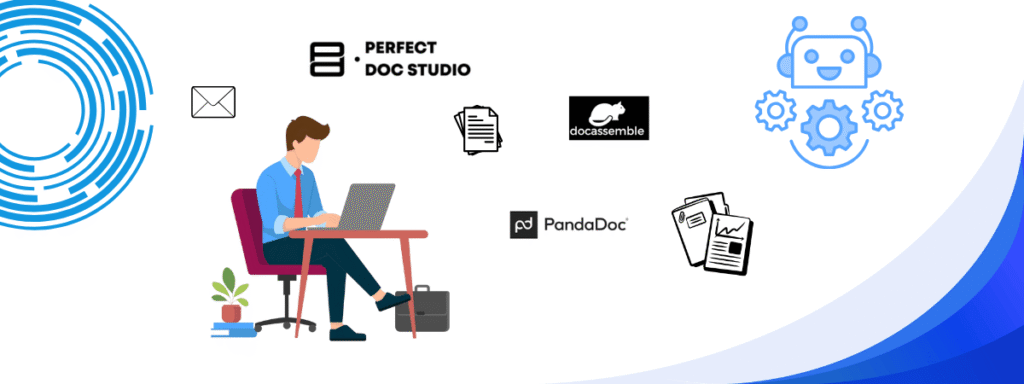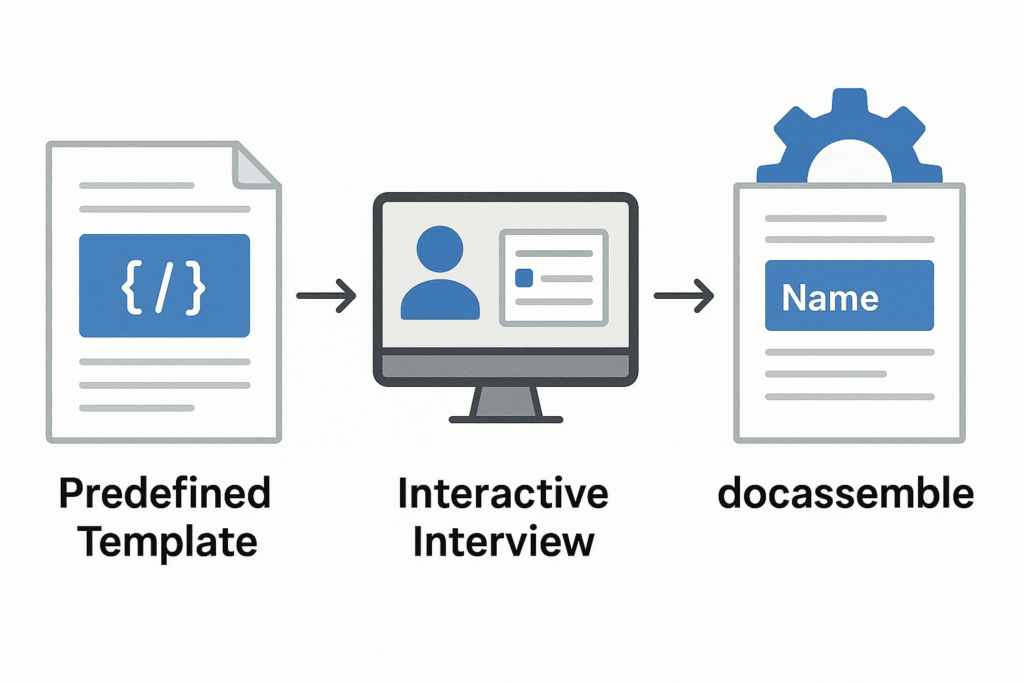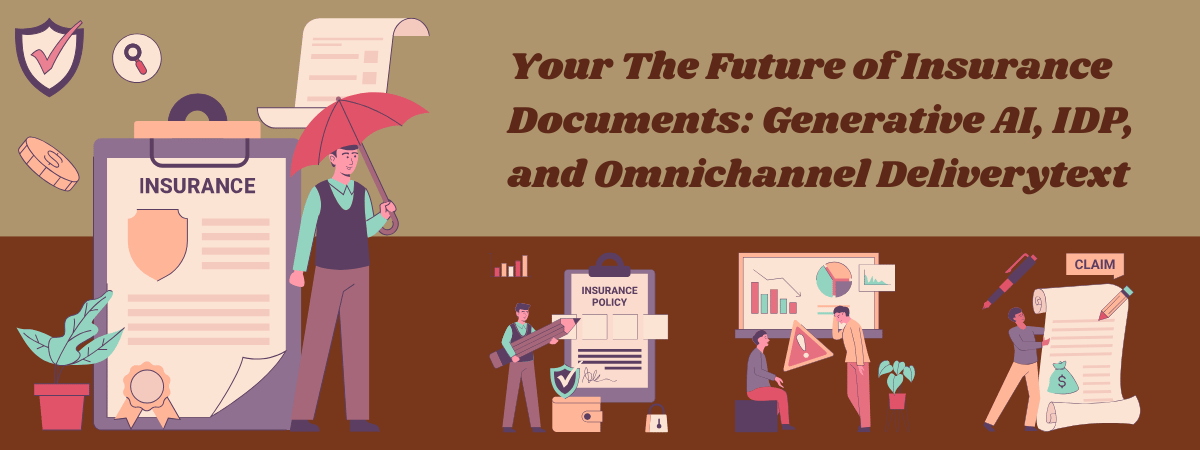How to Automate Template-Based Document Creation: 3 Must-Try Tools Revealed

We’ve been manually creating documents for years now; in fact, although automation and templates have come around, people still copy and paste the information that needs to be swapped out. Imagine an insurance renewal letter; a template would exist, and all that needs to be done is to change the name, address, and anything else that fits.
All that has changed with the dawn of SaaS companies, which offer template-based document generation to streamline workflow, maintain brand consistency, and deliver error-free and compliant documents. The era of technology means you can generate as many documents in dozens, hundreds, or even thousands in minutes. The template takes care of all formatting and structure for you, saving the trouble of making the same changes over and over. Simply provide the data, and the software takes care of the rest, saving you time and minimizing mistakes or errors.
Now comes the important question: Which tools and methods actually deliver results that are suitable for your needs?
This guide will explain which methods deliver results, which tools can aid the process, and how to pick the right tool.
Curious about how dynamic content can improve your documents? Dive into our guide on dynamic document generation
What You’ll Learn
- What is template-based documentation and how it works. .
- How do the leading tools compare? Detailed breakdown and a comparison chart.
- Real users reviews
What Is Template-Based Document Generation?
Template-based document generation is a pre-created document template containing placeholders for dynamic information, like names, dates, and more. It is combined with input data; it could be from any data source like CRMs spreadsheets, form, or core business systems. Pulling in data such as user ID, transaction amounts, and dates, to auto-generate personalized documents, including contracts, quotes, invoices, letters, or reports.
How does the process work:
1. Utilize a template first:
● A template can be thought of as a “fill-in-the-blanks” form. It contains placeholders for personalized information (such as {{Name}}, {{Date}}, or {{Total}}).
● Programs like Word, PDF, and HTML can be used to create templates.
2. Include Your Details:
● You enter the precise data that needs to be entered into those spaces when you’re prepared to create a document, such as a date, an order number, or a customer’s name.
● A database, spreadsheet, or even a straightforward online form may provide this data.
3. Automate the Document:
● Your information is combined with your template by document generation software.
● Every document’s actual data is automatically entered into all of the blank spaces.
4. Obtain Your Document:
● A flawless invoice, report, or contract with all the necessary information in the appropriate locations is produced in a matter of seconds.
● The program can produce a large number of identical documents at once, such as monthly statements for hundreds of clients.
Unsure about a software and want to start small, check out our blog on 5 Best Ways to Generate Word Documents from Excel to see how you can automate documents with just Word and Excel
Popular tools supporting template-based document generation
Perfect Doc Studio (PDS)
Perfect Doc Studio is a no-code platform built for the business user and not IT teams. It is a tool that anyone can use to create a template using their drag-and-drop editor, or one of the pre-built templates from their vast template library. Don’t feel like drafting the content, use the AI “write for me” feature, just give it a prompt, and it generates your content for you. Perfect Doc Studio doesn’t just fill in template placeholders with information like name or address. It goes beyond that by incorporating dynamic elements like QR or barcodes, visuals, conditional logic, business rules, and much more.
Now you might think there are many tools out there that do the same? But you won’t find a tool as user-friendly as PDS. Not to mention, PDS offers multichannel output, so you don’t just stop with creating documents; you can send the finished documents through WhatsApp, SMS, email, fax, print, or even mail them. With integrations, it can also help you sign the documents and track them all from one dashboard.
Plus with workflow automation, you can simply automate the whole process every time someone fills in a form or new data is added to your CRM or data source. Once the document is generated, it is automatically routed for relevant approval from relevant people and viola, your document is ready and already sent to your customers, all without any manual intervention.
This not only makes sure that everything is the same and follows the rules, but it also cuts down on a lot of manual work, which lets you focus on what really matters, your customers.
Perfect Doc Studio might be just what you need, and it’s available on a freemium model, so you can get started at no cost.
How to Create a Dynamic Document in Perfect Doc Studio
1. Select or Create a Template: Start with a document template that is ready to use. Simply choose a template or use the visual, drag-and-drop editor to create your own.
You can add your logo, put dynamic placeholders, include a header, footer, or even an image or two.
2. Link Your Information: You can import data from databases, Excel spreadsheets, or your current business systems (such as CRMs or ERPs).
3. Include Adaptive Placeholders: When creating or modifying your template, include placeholders for personalized information, like “{{Customer Name}}” or “{{Due Date}}.”
4. Create Your Documents: Click to create documents after setting up your template and data. Perfect Doc Studio automatically completes all the customized fields and creates polished, expertly formatted files in PDF.
5. Share, Email, or Download: With a few clicks on the platform, you can now download, email, print, or even share your generated documents via WhatsApp or SMS.
6. Monitor and Analyze: Track and monitor your open rates, document performance, and more from the analytics dashboard.
Perfect doc studio offers a practical approach to template-based document generation, especially ideal for non-technical users, simply because of how easy it is to handle and use. It adds more power and flexibility by expanding upon an intuitive interface, which makes it a good option for non-developers handling structured documents.
Pandoc
PandaDoc is a cloud-based document automation platform that can help users create, send, track, and e-sign digital documents. It uses a drag-and-drop builder just like Perfect Doc Studio and many other tools in the market. PandaDoc includes a staggering feature list like a modern web interface, template library, approval workflows, native e-signature, and real time analytics.
For a deeper look at how communication impacts the insurance industry, check out our blog’s complete guide to Insurance Customer Communication Management (CCM) in 2025.
How to Create a Template-Based Document Using Pandadoc
1. Create or Select a Template:
Once you log in to your PandaDoc dashboard, you can choose an existing template or create your own with the drag-and-drop builder. Then, add placeholders for any dynamic information.
2. Populate The Document:
Include bind fields to CRM variables for auto population, you can add, remove, or rearrange text, images, tables to suit your needs.
3. Assign Recipients and Roles:
Assign who needs to view it for approval or sign it. Give each party a role, like signer, viewer, approver before sending out the document.
4. Send for Review and Signature:
Send the approved documents by email or a secure link, both the sender and recipient can add comments or request changes in real time.
5. Track, Manage, and Story:
The dashboard will show the document status, whether it was viewed, signed, or is still pending. All your documents will be organized and stored securely within PandaDoc or synced with your cloud storage.
Refer to the link for detailed instructions on the document generation process.
Looking for the right tool to streamline your business documents? Explore our curated list of the top 10 document generation tools.
Here is an entirely free tool: An open-source ecosystem with sample projects, custom extensions, and regular updates.
DocAssemble
An open-source platform called Docassemble was created to automate document generation and create interactive web-based interviews. Designed mainly for professional and legal applications, it enables users to design guided forms that pose questions and produce tailored documents according to the answers. Because the system is based on Python and YAML, developers can create logic-driven interviews with dynamic content, conditional paths, and repeat loops.
Docassemble’s primary features include support for Word and PDF document templates, sophisticated logic branching, integrated database storage, and user authentication. It also provides features like file uploads, email notifications, RESTful API integration, and e-signatures.
Docassemble is ideal for automating legal forms, contracts, intake procedures, and other structured documentation workflows across industries because it has an integrated web server and flexible deployment options, including Docker.
How DocAssemble Operates for Non-Technical Users:

1. Start an Interactive Online Interview
Users go through an online “interview” consisting of a series of simple questions (similar to completing a form). For instance, it may request your name, address, date, and other information required to complete a form.
2. Dynamic Workflow
As users answer, DocAssemble uses logic to determine the following questions. Examples of this could be ‘branching if statements,’ ‘repeatable sections for multiple parties,’ and similar features.
3. Template Population
Your responses are automatically entered into a template that has been professionally created (such as a Word or PDF document). Think of it as “fill in the blanks”; each document is unique because the software inserts your responses into the appropriate spots in the template.
4. You get a ready-made document
DocAssemble immediately generates your finished document (in Word, PDF, or other formats) after you have finished answering the questions. It is available for download, printing, sharing or e-signature.
5. Optional Integrations
Advanced workflows can trigger additional notifications, database writes, or third-party API actions as long as the configurations are done (this of course, needs some developer help).
Here is DocAssemble’s beginner’s guide published on their official site.
If your work involves contracts or legal paperwork, our roundup of must-have legal document generation software in 2025 highlights trusted platforms built for legal professionals and law firms.
Here is a comparison table that highlights key features and functionalities for all three methods mentioned:
| Feature/Criteria | Perfect Doc Studio (PDS) | PandaDoc | Docassemble |
|---|---|---|---|
| Template Builder | Drag-and-drop, pre-built & custom, reusable sections, AI “write for me” | Drag-and-drop, large library, content blocks | YAML/Python logic, integrated templates (DOCX/Markdown) |
| Dynamic Elements | Barcodes, QR codes, conditional logic, business rules, images, tables, charts | E-signatures, comment threads, pricing tables | Conditional branching, repeatable sections, and custom fields |
| Automation & Workflows | End-to-end workflow automation, batch jobs, and auto-routing for approvals | Workflow approvals, reminders, and activity tracking | Logic-driven interviews, automation via Python/YAML |
| Multichannel Output | Email, SMS, WhatsApp, print, fax, voice, fillable PDF, web, mail | Email, secure link, cloud storage, e-signature, approval flows | Download, print, email, optional e-signature, RESTful API |
| Integrations | Native CRM/BPM (Salesforce, Oracle), API, Zapier, cloud/app connectors | CRM (Salesforce, HubSpot), payment gateways, and cloud storage | Database, RESTful API, Docker, web server deployments |
| User Access & Security | Role-based access, audit trail, compliance management, 24/7 support | Permissions, audit trail, compliance, secure storage | User authentication, access control, open source |
| Analytics & Monitoring | Performance dashboard, open rates, job monitor, batch tracking | Real-time analytics, view/sign status | Completion status, activity logs |
| Best Use Cases | Non-technical business users, omnichannel communication, scalable workflows | Sales, contracts, proposals, e-signature workflows | Legal documents, intake, applications, custom process |
| Unique Differentiators | AI-powered content, user-friendly interface, multilingual, batch generation, native integration | Modern UI, strong e-signature, approval flows, analytics | Advanced logic, full flexibility, open source/community |
| Ease of Use | User-friendly, no IT required | User-friendly, basic setup required | Developer-friendly, technical configuration required |
Pros and Cons: Community Wisdom
Advantages:
● The biggest advantage is that it saves you time and, in many cases, money as well (preventing you from making costly human errors and compliance issues).
● A dedicated doc gen software can scale for batch document creation (100s or 1000s at once).
● It can produce documents in different formats and can integrate with various systems and data sources, making your job easier.
Drawbacks:
● Many users say technical setup and template updates can be challenging for code-heavy tools like Pandoc or DocAssemble.
● Maintaining templates in multiple languages or for different branding rules is labor-intensive unless tools provide smart management, Perfect Doc Studio is one such tool.
● High learning curve for developer-first tools. Its always better to choose a no-code platform if you have many non-technical users.
Conclusion:
With a document generation tool, anyone from teams to individuals can produce accurate, consistent documents more quickly by using the templates it offers. Different degrees of automation are provided by programs like Perfect Doc Studio, Docassemble, and PandaDoc, which range from developer-friendly tools to no-code interfaces. It’s suitable for small and medium businesses to implement them so they can save time and money elsewhere. Not to mention all the productivity they would be redirecting to business aspects that matter. Your needs will determine which tool is best for you, but implementing template-based generation is essential for more effective document workflows.
Tired of repetitive manual work? Let templates do the heavy lifting. Try Perfect Doc Studio for free!
FAQs
Template-based document generation uses reusable templates that are automatically filled with data to create standardized, customized documents like invoices, reports, and contracts. Template-based document generation is a pre-created document template containing placeholders for dynamic information. It saves time, reduces manual errors, and ensures consistency across all documents. This approach is ideal for businesses that handle high volumes of paperwork. It also allows for easy updates, changing the template once, and all future documents reflect that change.
Data from external sources (such as databases, CRMs, and spreadsheets) is pulled into templates by users using placeholders. This data is combined by the software to create final documents in Word, HTML, and PDF formats.
Organizations frequently use templates as a starting point for producing standard business documents like memos, faxes, and letters. You only need to type because a template will include all of the formatting, page layout, headers and footers, styles, and other elements needed to create the new document!
Time is saved and consistency across all documents is guaranteed when templates are used. They are particularly helpful in keeping business communications looking branded and professional.
When choosing a platform, take into account the technical proficiency of your team, the volume of documents, integration requirements, and preferred output formats.
Also, consider ease of use, scalability as your business grows, and the level of customer support provided. Security features and compliance with industry standards are important for sensitive documents. Finally, look for software that offers customization options to fit your specific business needs.
Contracts, invoices, reports, letters, proposals, onboarding forms, marketing materials, and other types of documents can be generated using templates.
Email Verification Page Design – Best Practices & Great Examples
The surrounding technology is advancing at a fast pace. Though it brings ease and facilities, it als
Top 3 Tools to Make PDFs Accessible in 2025
As digital accessibility becomes a legal mandate across the EU starting June 28, 2025, organizations
Intelligent Document Operations in Insurance: The Future of Insurance Documentation
This blog explores how intelligent document operations are quietly revolutionizing the insurance ind




